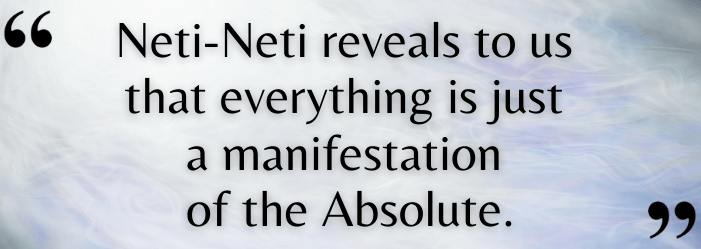Episode 7: A review of "Neti-Neti Meditation" by Andre Halaw (Part 1)
Podcast Episode #7: A review of Andre Halaw's book Neti-Neti Meditation chapters 1–3
Click here to see the video version on YouTube or scroll down to see the video embedded on this page.

In Episode 6, I talked about my takeaways from Andre Halaw’s book, “God is Nothingness”. Now I’ll discuss another book by Halaw called “Neti-Neti Meditation”. This episode will be split into two parts as this book delves deeply into the process of negation, how it applies to meditation, and how meditation conveys to everyday life.
One of the most basic concepts Halaw puts forth is that what you think is…just a thought. Thoughts are not reality, yet they can lead to emotions like fear, hate, and anger that cause physical changes in our forms—tensed muscles, grinding teeth, increased heart rate. This physical response reinforces the thought you just had—if this person, place, or thing makes me feel this way, my thoughts about it must be true. The reinforced thoughts then self-validate the feelings. This circular validation happens within moments of an interaction, and it happens to all of us when we are ruled by our emotions.
The Neti-Neti process allows us to see beyond the thoughts that we have about people and things. It frees us from the habit of seeing the world in rigid, unchanging terms based on thoughts and emotions derived from limited data. It also acknowledges that there is no such thing as experiencing raw reality. Our senses provide input to the nervous system which then processes it based on our past education and experiences. By the time our nervous systems process the data and we have a thought or emotion, Reality has changed.
Through Neti-Neti meditation, we question the nature of Reality. Who am I? What am I? Am I my body? Am I my mind? Am I my thoughts or emotions? When I am angry, where is that emotion? Am I anger? Where does anger come from, and where does it go? As we examine the anger, it loses its identity and it loses its power over us. We can understand this emotion as simply a part of human experience and then let it go.
All emotions can then be transcended, experienced as part of the nondual fabric of Reality. Emotions do not define us, but they are integral to our human experience in this world. Our goal along our spiritual journey is to recognize our humanity while not falling victim to the whims of the ego and its array of emotions.
Neti-Neti reveals to us that everything is just a manifestation of the Absolute. We identify a rock as a rock because that is what we have been taught to call a hard conglomeration of minerals in that form. In reality, it is just the Absolute manifesting as a form that we call a “rock”.
As Halaw puts it, “Neti-Neti exposes everything we can conceive of to be just ideas, thus negating their reality as things.” When we examine any “base object”—defined by Halaw as anything we can “perceive, sense, experience, or investigate”—we will eventually find it lacking any sense or logic. This leaves us with, as Halaw puts it, “a nondual experience beyond words.” Buddhists call this Thusness or Suchness, a direct manifestation of Reality beyond words and concepts.
Halaw writes that when we recognize that our “I”-ness is just our idea of self projected onto the manifest world, we see the reality beyond the delusion, the beautiful Thusness that is in us and is us. This allows us to see that we are all just expressions of the Absolute, Neti-Neti, “not this, not that.”
Halaw talks about the Hindu and Buddhist cycle of Samsara. Samsara is defined by emotional turmoil, the ups and downs of our human feelings that can go from extreme highs to extreme lows within minutes or hours. Halaw stresses that just exchanging bad thoughts for good thoughts in order to bring on good emotions is not enough. Attachment to any thought will only lead to suffering. Instead, we must come to realize that we are “not this, not that,” beyond thought and feeling, beyond awareness. We are the Absolute from which everything springs.
In Chapter Three of “Neti-Neti Meditation,” Halaw takes us through an exercise to help us learn how to use Neti-Neti to navigate our everyday lives.
First, he tells us to identify a base object that needs investigating. This can be anything—a thought, emotion, etc. He uses the emotion of frustration as an example.
Instead of trying to figure out why you are frustrated or what led to the frustration, you must see the emotion for what it is. Deny the emotion its power by taking a deep breath and allowing yourself to witness it objectively. Remember that frustration is the result of thoughts, which lead to emotions, which are not Reality. In reality, there isn’t even an “I” to be frustrated.
Now that you have defused the base object’s emotional power, experience it fully. What is its texture? Where in your body do you feel a reaction to it? What other emotions does it elicit? Where do those feelings manifest in your body?
Carefully witness each of these emotions and feelings as they appear, but do not try to make them disappear. Your role is not to change the base object into something more pleasant. You should neither push it away nor pursue it, just examine it.
If the base object (in this case frustration) disappears, you may ask, “What was it, and where has it gone?” The answer is always, “It arose from and has subsided into Emptiness.” It was never more than an idea.
One reason we find ourselves attached to or repelled by certain thoughts or emotions is that we tend to apply labels to them such as “good” or “bad”. Neti-Neti allows us to transcend these labels along with the objects, dissolving their hold over us. We do this by identifying the emotion along with any physical response. It also helps to identify any other charged thoughts or labels related to the emotion—for example, shame, anger, or frustration at being frustrated. Once we identify them, we can observe them and let them go.
According to Halaw, “The longer we observe an emotion or thought without actively engaging it or acting upon it, the more detached we grow, as it becomes apparent that whatever we are observing is not us, and thus we are free from it.”
When we stop labeling any base object as good or bad and we strip away the labels and the charged thoughts about it, it stops being an object. As its form and substance disappear, we can recognize that it just “is.” Just like you and me and everything else in the universe, this object is not a “thing”, it is merely a part of Thusness, the nonduality that encompasses us all.
The big questions in Neti-Neti meditation are usually, “What is this? Is this me? Is there any ‘I’ in there?” Halaw notes that traditional forms of Neti-Neti skip past the identifying and de-labeling of base objects and jump straight to teaching that you are “not this, not that.”
But Halaw says that it’s not enough to simply reject all things as not us. We must also realize our part in Nothingness, that our bodies do not exist in a way that defines us. Halaw refers to The Buddha’s Diamond Sutra, which teaches that to be free of the objects of the world, we must empty them of their self-hood. To do this, we must, for example, negate the body’s “body-ness”, the eye’s “eye-ness”, etc. When all of a body’s properties are negated, we are left with only an idea and no “thing” to attach to. With no “thing” to attach to, we are no longer separated from everything else in the universe. This leaves us ready to tackle the question, “Is this me?”
The answer to this question is always “No,” but there is more to it than that. A simple “No” implies there is a different answer. If you go looking for the “I” of your Self, you will find that, like all other “things”, it is merely an idea.
Once you come to this realization, you have unlocked the door to nonduality. This may be enough for many who want to improve their everyday experiences with equanimity and grace.
But Halaw offers one final step for those who want to go further in the Neti-Neti process. He invites us to negate all that remains. For those who have experienced the Absolute through formal meditation practice (something he describes in Chapter 4), he explains how to bring awareness of the Absolute into our everyday lives.
Halaw says that anything you experience—all sights, sounds, thoughts, and even nondual experience—is not the ultimate truth and must be cast aside. Doing this, you will pass from “the void of Thusness” to “the Void-with-a-capital-V of Nothingness”.
All experiences involve change, but the Absolute is unchanging. Anything you experience is not It-with-a-capital-I; it is all Neti-Neti.
In the end, once everything has been negated and the universe has been emptied of its contents, only the Absolute, “your true face,” remains. Since there is nothing left to say “not this, not that” about, we have negated the process of negation itself. We have transcended Neti-Neti, and all separateness about the world falls away.
In the next episode, I’ll discuss chapter four and beyond of Halaw’s “Neti-Neti Meditation”. In the meantime, identify some of the emotions you go through each day. Examine them and try to understand the thoughts that bring on these emotions (and vice-versa). Consider how you might be able to avoid emotional turmoil associated with certain thoughts and actions by approaching things more objectively. This will help prepare you for bringing Neti-Neti into your daily interactions.
I’ve found that when I do these things, I’m much calmer and content. When I forget these lessons and allow frustration or fear or another emotion to possess me, I become very uncomfortable. And when I find myself too busy with everyday life to take 20 minutes for meditation, I’m much more susceptible to emotional turmoil. Feeling guilty about that won’t help though, so I just get back to it when I can. The more I practice the meditation, the easier it is to live the Neti-Neti way and love life for what it is.
-------------------------
Link to "Neti-Neti Meditation" by Andre Halaw on Amazon.com: https://smile.amazon.com/dp/B00GP62LU0
Link to "True Meditation" by Adyanshanti on Audible.com:
https://www.audible.com/pd/True-Meditation-Audiobook/B002V0153I?asin=B002V0153I

